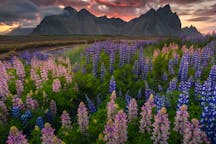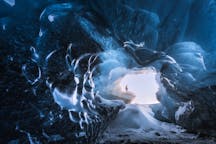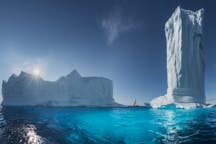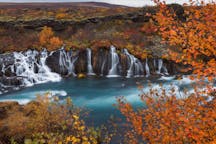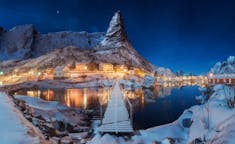
Guide to the Aurora Forecast in Iceland
- What are the Northern Lights?
- Can You See the Northern Lights in Iceland?
- The Best Time to See the Northern Lights in Iceland
- How to See the Northern Lights in Iceland
- What is Solar Activity?
- Real-Time Aurora Forecast for the Northern Hemisphere
- NOAA OVATION Aurora Forecast
- Icelandic MET Office
- Aurora Service Europe
- Aurora Forecast Iceland
- How Accurate are the Aurora Forecasts?
- Best Spots to See the Northern Lights in Reykjavik
- Scenic and Sculpture Walk by the Coast
- Oskuhlid Hill
- Grotta Lighthouse
- Reynisvatn
- Kopavogskirkja
- Geothermal Pools
- Best Locations to See the Northern Lights Around Iceland
- Thingvellir National Park
- Threngsli and Threngslavegur
- Vik
- Jokulsarlon Glacier Lagoon
- Vestrahorn
- Godafoss
- Lake Myvatn
- Hvitserkur
- Kirkjufell
- Black Church of Budir

Would you like to catch a glimpse of the Northern Lights? This elusive natural phenomenon is a bucket list item for many travellers coming to Iceland. While predicting the Aurora forecast may not be an easy task, here is everything that you need to know to maximise your chances of seeing the Northern Lights during your trip.
- Discover this 11 Day Northern Lights Photo Workshop around Iceland
- Check out this The Ultimate Guide to Photographing the Aurora in Iceland
- Join us on a Private Northern Lights Photo Tour
What are the Northern Lights?
The Northern Lights (aka Aurora Borealis) are an incredible phenomena that may be seen in the northern hemisphere. This natural light show is caused by solar winds travelling away from the sun, which enter the Earth’s magnetosphere. As the electrically-charged particles from the sun collide with gaseous particles such as oxygen and nitrogen, they create different colours in the night sky which may be seen around the magnetic north pole.
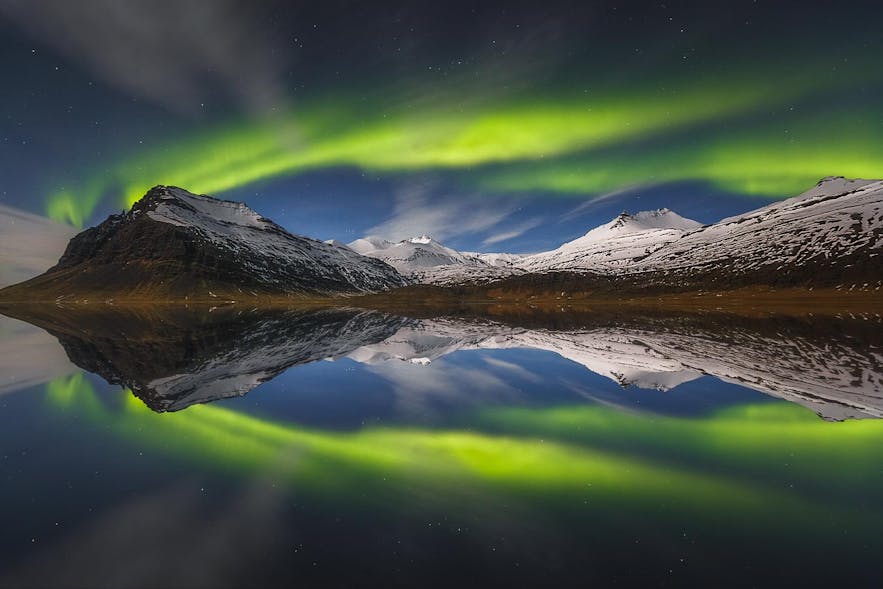 The Northern Lights are an atmospheric phenomena. Photo by: 'Iceland Photo Tours'.
The Northern Lights are an atmospheric phenomena. Photo by: 'Iceland Photo Tours'.
Can You See the Northern Lights in Iceland?
The short answer is: yes! Iceland is situated just a few degrees south of the Arctic Circle (66°30'N), meaning that it’s one of the best places in the world to see the Northern Lights. Moreover, there is little light pollution in Iceland. Combined with awe-inspiring natural landscapes and vast expanses of dark sky at night, you’re already on the way to making a great recipe for witnessing or photographing the Aurora.
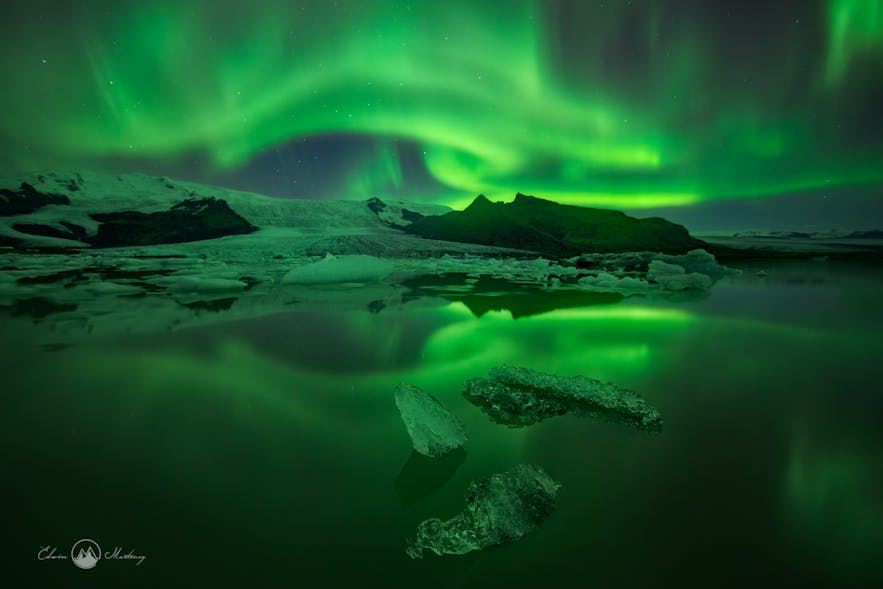 The Northern Lights are visible from Iceland. Photo by: 'Edwin Martinez'.
The Northern Lights are visible from Iceland. Photo by: 'Edwin Martinez'.
The Best Time to See the Northern Lights in Iceland
The Northern Lights are visible in Iceland from late August until April, which largely coincides with the autumn and winter months, as well as the beginning of spring. To maximise your chances of viewing the Northern Lights though, you should aim to visit during the season when there is the most darkness, which is winter. Short days and long nights will mean you’ll have more opportunities to chase this elusive phenomena!
These are the best months to see the Northern Lights in Iceland:
August
Towards the end of the month, the nights will begin to get darker, meaning that you’ll have a good chance of seeing the very first Northern Lights displays of the season. Keep your eye on the Aurora forecast in Iceland for your best chances.
September
This is the beginning of autumn in Iceland, when the nights will begin to get longer and longer. There won’t be much snowfall around, though it will get a bit colder. Solar activity is usually high during this month, so it’s one of the best times to see the Northern Lights in Iceland.
October
During October, it will begin snowing, particularly in the north of Iceland. While it will be cold, the temperatures generally won’t be as low as they are in the midst of winter. This is a good time for seeing the Northern Lights in Iceland, especially during the first two weeks of the month when solar activity may be high.
November
This is the beginning of winter in Iceland, when the country will experience snowfall in most regions as well as icy conditions. You’ll have ample opportunities to see the Northern Lights with longer periods of darkness, though the weather may be unstable, resulting in cloudy skies.
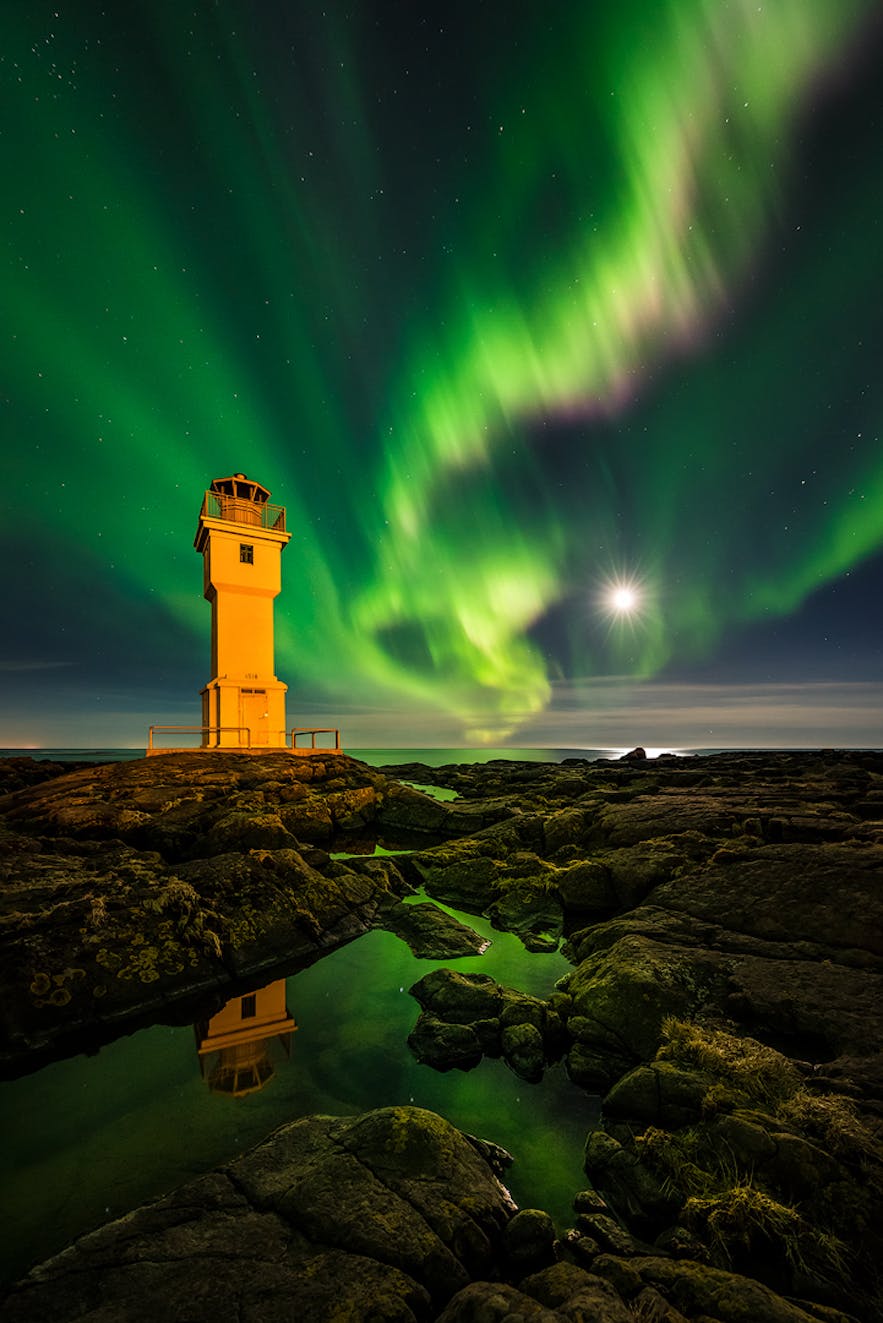 Autumn is one of the best times to see the Northern Lights in Iceland. Photo by: 'Iceland Photo Tours'.
Autumn is one of the best times to see the Northern Lights in Iceland. Photo by: 'Iceland Photo Tours'.
December
December is one of the darkest months in Iceland, with only 4-5 hours of daylight. This is a good time to travel if you want to avoid the tourists and with so many hours of night, you’ll have a good chance of viewing the Aurora.
January
This is the best month for Northern Lights photography in Iceland. Generally speaking, the weather will be a lot more stable and the landscape will be swathed in a covering of snow, making for truly breathtaking scenery. It is one of the coldest months in Iceland though, so be prepared to rug up if you’ll be staying out all night!
February
It will still be fairly cold in Iceland and you’ll have wonderful chances to both see and photograph the Northern Lights, though the days will begin to get a little bit longer. There will also be many more tourists about, particularly at the main waterfall attractions on the Golden Circle route and South Coast of Iceland.
March
This month marks the end of winter in Iceland. There will still be a bit of snow and ice about, though the days will begin to get much longer. Solar activity usually increases around the spring equinox, so you’ll have a good chance of seeing the Northern Lights.
April
This will mark the end of the Northern Lights season in Iceland. The number of daylight hours will increase dramatically, meaning that you’ll have fewer opportunities to see the Northern Lights, though they may still make a rare display.
 The Northern Lights are visible throughout winter and autumn. Photo by: 'Iurie Belegurschi'.
The Northern Lights are visible throughout winter and autumn. Photo by: 'Iurie Belegurschi'.
How to See the Northern Lights in Iceland
To maximise your chances of seeing the Northern Lights in Iceland, the first thing that you’ll need is dark skies. It is not possible to see the Aurora Borealis in Iceland during summer, as there is simply too much daylight. As such, aim to visit during the months of autumn and winter, the months when it is darkest in Iceland.
You’ll also have to consider two other variables which affect the skies – cloud cover and solar activity. While solar activity may be more pronounced during the March and September equinoxes, you won’t have much of a chance of seeing the Northern Lights if the skies are cloudy. Similarly, even if the sky is clear, you won’t be able to see the Aurora if there is very little solar activity.
However, it is still possible to see the Northern Lights when it’s cloudy, provided that you are able to find a gap in the clouds where the sky can peek through.
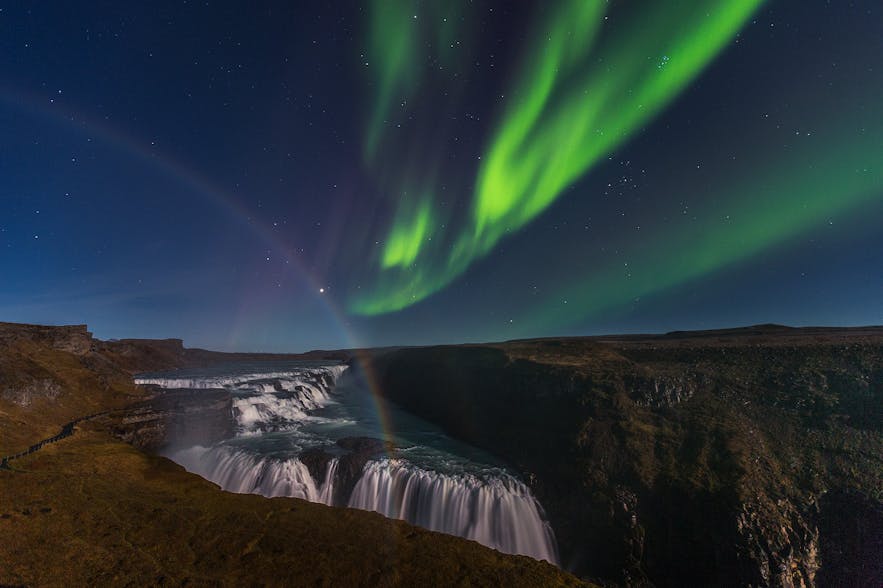 It is possible to see the Northern Lights with a clear sky. Photo by: 'Iurie Belegurschi'.
It is possible to see the Northern Lights with a clear sky. Photo by: 'Iurie Belegurschi'.
What is Solar Activity?
The Earth is constantly being blasted by solar winds from the sun; this is what causes Aurora activity. However, the solar winds need to reach a certain intensity before they can create the colourful displays of the Northern Lights that we see in the night sky.
Solar activity is measured using a numerical system called the ‘Kp index’. This was first introduced to the world in 1939, by the German scientist, Julius Bartels. It stands for “Kennziffer Planetarische”, which translates loosely to “planetary index number”.
The Kp index ranges from 0 to 9, where 0 indicates little to no geomagnetic activity, while 9 indicates an extreme geomagnetic storm. According to this scale, the higher that the Kp number is, the more of a chance that you will have to witness the Northern Lights.
You can refer to scale below for more information about when you’ll be able to see the Aurora:
-
Kp 0-2: Little or no solar activity. However, if the skies are clear, then you should still head out just in case!
-
Kp 2-3: Moderate solar activity. You’ll have a good chance of seeing the Northern Lights. This is the most common forecast in Iceland, so head out if you can.
-
Kp 4-6: This indicates that a solar storm is on the way. You can expect to see a great display of the Northern Lights and maybe even a corona!
-
Kp 7-9: This indicates that the sky will be ablaze with the Northern Lights, though a Kp-index this high is very rare to see.
Real-Time Aurora Forecast for the Northern Hemisphere
Satellites are the main tools used for observing and monitoring the sun, as well as the particle fluxes heading towards Earth. They are used for compiling information and creating images of particle fluxes, such as coronal holes and sunspots. Below are a few of the websites that utilise this data to provide real-time aurora forecasts.
 The Northern Lights can be difficult to forecast. Photo by: 'Iceland Photo Tours'.
The Northern Lights can be difficult to forecast. Photo by: 'Iceland Photo Tours'.
NOAA OVATION Aurora Forecast
If you want to check whether the Aurora Borealis will be visible tonight in Iceland, then this handy website run by the National Oceanic and Atmospheric Administration (NOAA) is a great tool. The NOAA’s Oval Variation, Assessment, Tracking, Intensity and Online Nowcasting (OVATION) map uses solar wind and interplanetary magnetic field (IMF) inputs, allowing you to observe the intensity of aurora activity in real time for both the northern and southern hemispheres and is updated every 30 minutes.
The OVATION Aurora Forecast Model is particularly useful for predicting whether you’ll be able to see the Northern Lights in Iceland, as it shows both the intensity and location of the possible Aurora during a particular time frame, which you may ascertain from looking at the top of the map. This forecast is based on current solar wind conditions, which take approximately 30 minutes to an hour to reach the Earth.
 The green oval. Photo by: 'NOAA'.
The green oval. Photo by: 'NOAA'.
To interpret the Aurora Forecast provided by the NOAA, what you are looking for is a coloured oval superimposed over the map of the Earth. Areas of light green indicate a low chance of aurora activity. On the other hand, areas of light yellow, orange and red indicate that the chances of seeing the Northern Lights in Iceland are very high. If the coloured oval is positioned over Iceland on the map, then it means that the Northern Lights should be visible in Iceland within the next 30 minutes.
On this map, the blue colour indicates that it is daylight on that side of Earth, while the black represents night. You will not be able to see the Aurora during daylight hours, though you will most likely be able to observe it within an hour before sunrise or after sunset.
Icelandic MET Office
One of the most reliable sources for tracking and predicting Aurora activity online is the Icelandic Meteorological Office. On their website, you can see a 6-day forecast Aurora forecast by Geomagnetic Activity level (Kp index).
To figure out the Kp index for tonight, simply refer to the scale at the top right-hand side of the page.
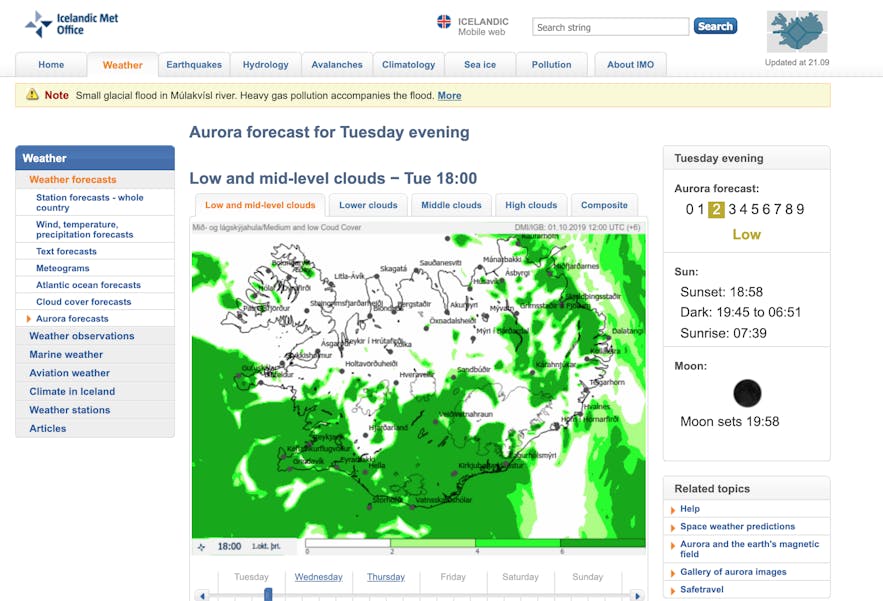
However, as we mentioned earlier, the Kp-index is not the only variable that you’ll need to refer to for an accurate prediction of the Northern Lights. To be able to see the Aurora, you’ll need dark and partly clear skies. Thankfully, this website also provides a cloud cover forecast with a map of Iceland for low and mid-level clouds, as well as high clouds, which may affect your viewing opportunities.
By using the cloud cover map in conjunction with the Kp-index, you’ll be able to see which areas of Iceland will be best to visit to increase your chances of seeing the Northern Lights. Green areas on the map mean that the skies will be cloudy, while white areas indicate that the skies will be clear. You can move the slider around to see cloud cover during different times and days, in order to detect the best time to see the Aurora within a certain part of Iceland.
Aurora Service Europe
The Aurora Service Europe monitors solar activity, geomagnetic activity and real time solar wind conditions to provide hourly, daily and even a 3-day forecast for the Aurora Borealis. It also uses the NOAA Ovation Aurora Forecast on its website, though it includes a few other tools that may be handy, using real-time solar wind data from NASA’s ACE spacecraft.
On the site, you’ll see a number of solar wind gauges. These gauges are updated every 60 seconds from data sent by the ACE spacecraft. The updates are live, meaning that you won’t even have to refresh the site to be able to see what is happening in terms of solar wind activity.
Beneath the gauges, you’ll see a number of charts resembling a heart-rate monitor. While this data could look a bit like your own heart-rate after seeing the Northern Lights for the very first time, it actually refers to the intensity and speed of the solar winds impacting upon the Earth’s magnetic field. On the magnetometer stackplot, small variations usually indicate a flux of particles from the sun, while large swings in the data indicate that Aurora activity is currently occurring and you should be able to see the Northern Lights, provided that you are in the right location with dark and clear skies.
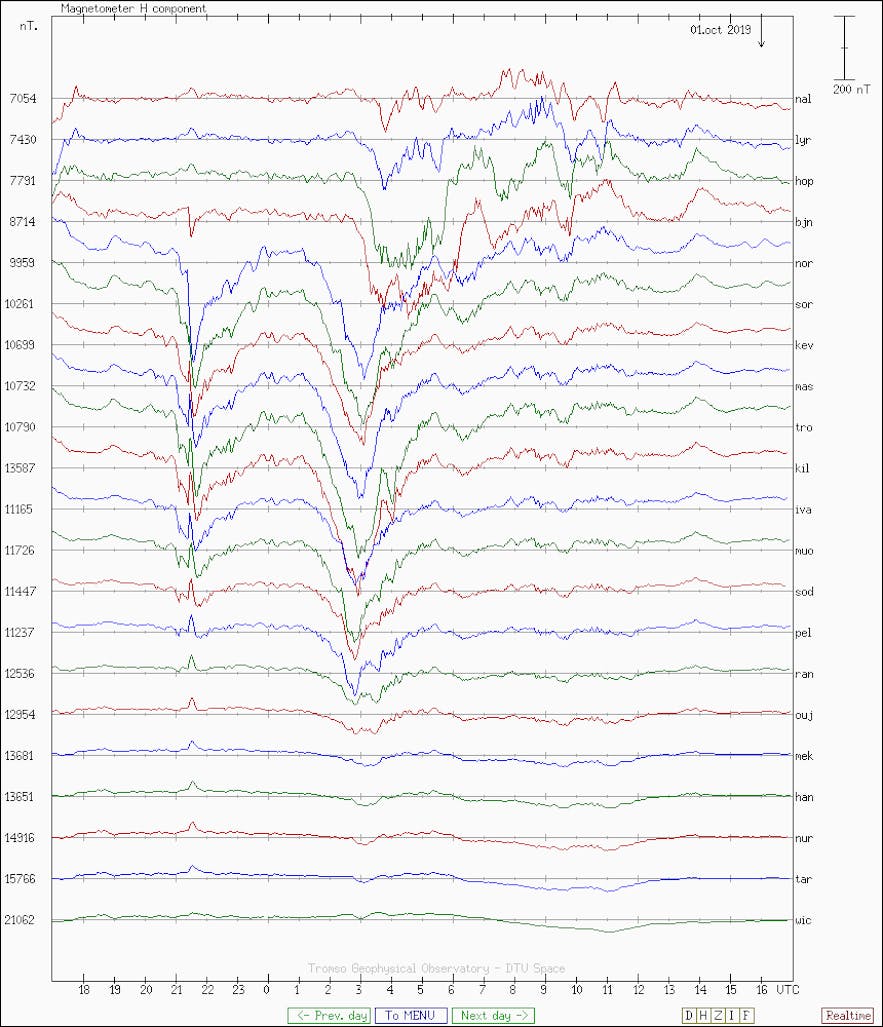
There is also a good map of Europe on the website, which shows what the Kp-index needs to be in order for you to see the Aurora Borealis where you are. During high activity, the Aurora will often be visible from a much lower latitude, so you may be able to see it even if you are located in more southerly countries, such as Scotland, Ireland, Denmark, or Estonia.
Aurora Forecast Iceland
This website gives a bit of an overview of all of the tools listed above, on one easy-to-read page. You can see the Kp-index forecast, cloud cover forecast from the Icelandic Met Office, real time space weather data from NASA, the NOAA Ovation Aurora forecast, charts from the Leirvogur Magnetic Observatory in Iceland indicating measurements of Earth’s magnetic field, as well as solar activity.
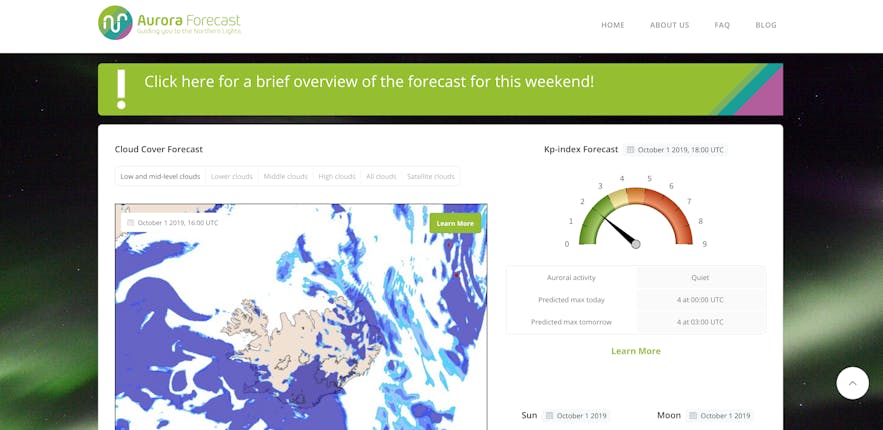
Perhaps the tool that stands out most on this website is the data drawn from the Leirvogur Magnetic Observatory, which is owned and operated by the Science Institute of the University of Iceland. This chart, much like the magnetometer stackplot mentioned above, is used to measure short and long-term variations in the magnetic field. Large swings in the data may be used to predict Aurora activity.
How Accurate are the Aurora Forecasts?
While Aurora forecasts may be a great tool for predicting when and where you might be able to see the Northern Lights in Iceland, the data can change throughout the day, meaning that the forecast is not always reliable. Sometimes, the KP-number can change from zero to six within half an hour. At other times, the prediction may be at zero, but you may still be able to see the Northern Lights.
As such, rather than relying completely on the Aurora forecasts, you should simply keep an eye on the cloud cover and the weather. If the sky is dark and clear, then you should head out anyway as you could have the incredible opportunity to glimpse the Northern Lights, no matter what the prediction may be!
 Keep an eye on the clouds rather than the Aurora activity! Photo by: 'Edwin Martinez'.
Keep an eye on the clouds rather than the Aurora activity! Photo by: 'Edwin Martinez'.
- See also: Winter Workshops in Iceland
Best Spots to See the Northern Lights in Reykjavik
Can you see the Northern Lights from Reykjavík? Why yes, you can!
There is absolutely no reason why you can’t see the Northern Lights in Reykjavík, unless it’s a cloudy night without any aurora activity. As we mentioned earlier, for the best chances of viewing the Aurora within the metropolitan region, you’ll need the magical formula of clear skies and geomagnetic activity.
There are plenty of spots in downtown Reykjavík where you’ll be able to witness the Northern Lights, should they make a display in the night sky. In fact, some of the best places to see the Aurora Borealis in Iceland are from within the city itself. Most of the locations are situated along the coast, where a broad horizon with few city lights makes for a great backdrop.
Scenic and Sculpture Walk by the Coast
If you’re staying in downtown Reykjavík, then it often pays to go for an evening stroll along the coast, following the scenic and sculpture walk by the Harpa. Here, you’ll have great opportunities to see the full extent of the Aurora dancing across the sky.
You’ll also find the Sun Voyager along this stretch of walkway, which makes for a great foreground to take a picture of the Northern Lights!
Oskuhlid Hill
Another great place to see the Northern Lights in Reykjavík is from Öskuhlið Hill. This location is just a short walk from downtown, near the glass dome of the Perlan Museum. You won’t be able to miss it, as the glass dome is visible from most places within the city.
If there is Aurora activity early in the evening, then head inside the museum to the viewing deck, where you’ll have spectacular views over the city and an expansive vista of the night sky. Perlan is open from 09:00 to 20:00 every day, so you’ll have ample time to see the Northern Lights if you happen to visit during winter when the days are shorter.
Grotta Lighthouse
While you don’t have to leave the city to see the Northern Lights, you may decide to head out a little bit further into the outskirts of Reykjavík, where there is less light pollution. With less ambient light, the Aurora will appear to be more vibrant, meaning it will be easier to see.
If you have a car and you’re willing to drive, then head towards the Grótta lighthouse on the Seltjarnarnes peninsula. This is by far one of the most popular places to watch the Northern Lights in Reykjavík, both amongst locals and visitors alike.
Once there, you will find a small parking lot where you’ll be able to park your car and wait for the Northern Lights to appear. It can get busy here though, so be sure to get there early if you want to find a place to park!
Reynisvatn
This is a small lake in the neighbourhood of Grafarholt, at the edge of Reykjavík city. The light pollution is low in this area so if the Northern Lights come out to play, then you’ll be perfectly placed not only to see them in the sky, but also reflected in the beautiful, glassy water.
Kopavogskirkja
Just a little south of Reykjavík, you’ll find the church of Kópavogur, located on the Borgarholt hill. You’ll have a spectacular view over Kópavogur, Reykjavík and surrounding area from here, as well as the night sky. This is a great location to see the Northern Lights, which is quieter than most. You’ll likely need a car to get there though, unless you’re staying in the area.
Geothermal Pools
It may come as no surprise that the outdoor swimming pools of Reykjavík are some of the best places to watch the Northern Lights. What could be better than taking a dip in steamy hot water while the Aurora dances in the starry sky above you?
You can try your luck in the hot tubs at Sundhöllin, the oldest public baths in Iceland, or head to Laugardalslaug, the most popular swimming pool in Reykjavík! If you’d like to head a little bit further out of town, try the Seltjarnarneslaug swimming pool, where the water comes directly from the town’s own reservoir and is filled with minerals that are great for your skin.
For those who are up for a more luxurious experience, nothing beats bathing in the luminous geothermal spas of the Blue Lagoon with the Northern Lights overhead. You can even make a dinner reservation either before or after you bathe, in addition to booking an in-water massage.
Best Locations to See the Northern Lights Around Iceland
If you’ll be heading out of Reykjavík on your journey, then you’ll have many more chances to see the Northern Lights. There are many locations all around Iceland that are perfect for watching the Aurora dance across the sky, as well as for practicing your Aurora photography skills if you happen to have a good camera with you.
Thingvellir National Park
One of the best places outside of Reykjavík to view the Northern Lights is at Þingvellir on the Golden Circle route. Simply head out past the Information Centre, where you’ll find a small hill. Pull over and you’ll have a great view of the sky over the National Park.
Threngsli and Threngslavegur
Þrengsli is a small stream by the Þrengslavegur road on Route 1, which is an incredible place to see the Northern Lights. There is very little light pollution in this area, due to the lack of buildings in the vicinity. During winter, the endless lava fields will likely be covered in snow, making for truly picturesque scenery and an enchanting Aurora experience.
Vik
While this small fishing village on the south coast of Iceland may be more well-known as a day tour destination for its famous black sand beaches, Vík is also a wonderful spot to witness the Northern Lights.
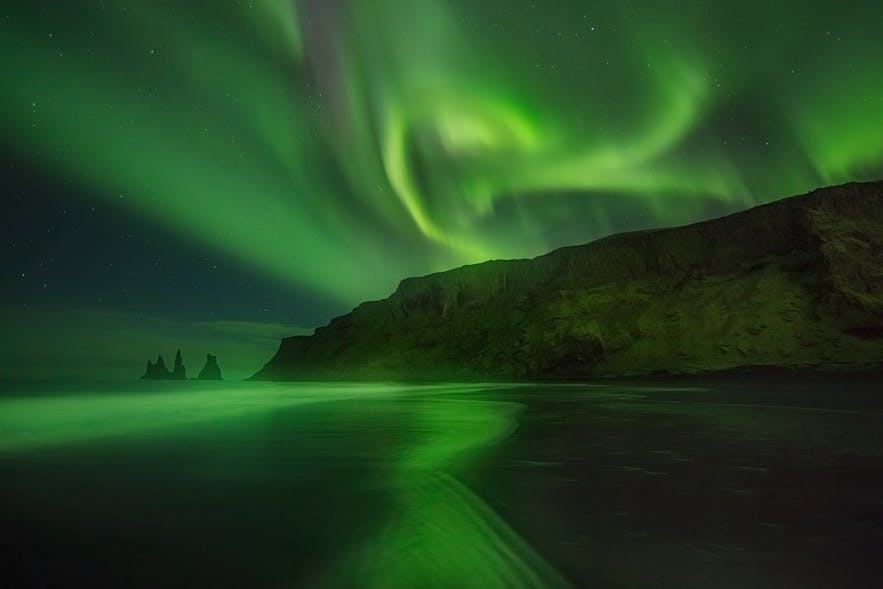 Aurora over the Reynisdrangar sea stacks. Photo by: 'Iceland Photo Tours'.
Aurora over the Reynisdrangar sea stacks. Photo by: 'Iceland Photo Tours'.
You can head up to the hill where you’ll find the Vík í Mýrdal church. There is a small parking lot there where you may sit in your car and wait for the Aurora to appear. It’s quite a spectacular viewpoint, from which you’ll be able to see the city lights below and the Reynisdrangar sea stacks in the distance.
For those wanting to photograph the Northern Lights, try visiting the Reynisfjara black sand beach, where you’ll be able to capture them dancing over Reynisdrangar towards the Dyrhólaey promontory behind you.
Jokulsarlon Glacier Lagoon
What would a trip to Iceland be without visiting the Jökulsárlón glacier lagoon? This is one of the premiere places in Iceland to see the Northern Lights. There’s nothing quite as enchanting as seeing the Aurora dancing over spectacular icebergs as they drift towards the ocean!
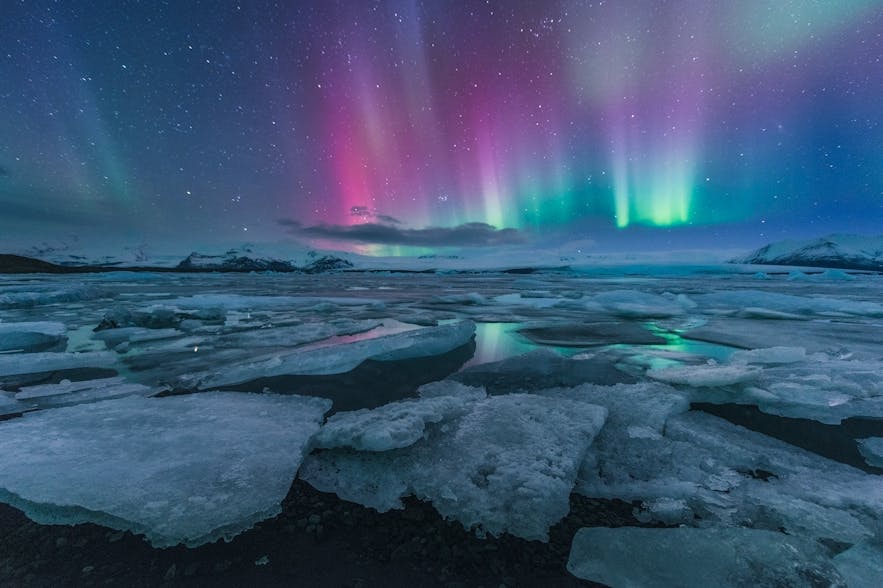 Aurora over the glacier lagoon. Photo by: 'Iurie Belegurschi'.
Aurora over the glacier lagoon. Photo by: 'Iurie Belegurschi'.
Nearby, you’ll find the Diamond Beach – another great place to witness this atmospheric phenomena. With a full moon, you’ll be able to see the glistening icebergs on the beach in detail, while the Aurora lights up the sky overhead.
Vestrahorn
This is one of the most coveted spots for Northern Lights photography in Iceland, though capturing a great photo there is not without a challenge. While there may be lots of geomagnetic activity, it can be difficult to visit Vestrahorn on a night when there are clear skies.
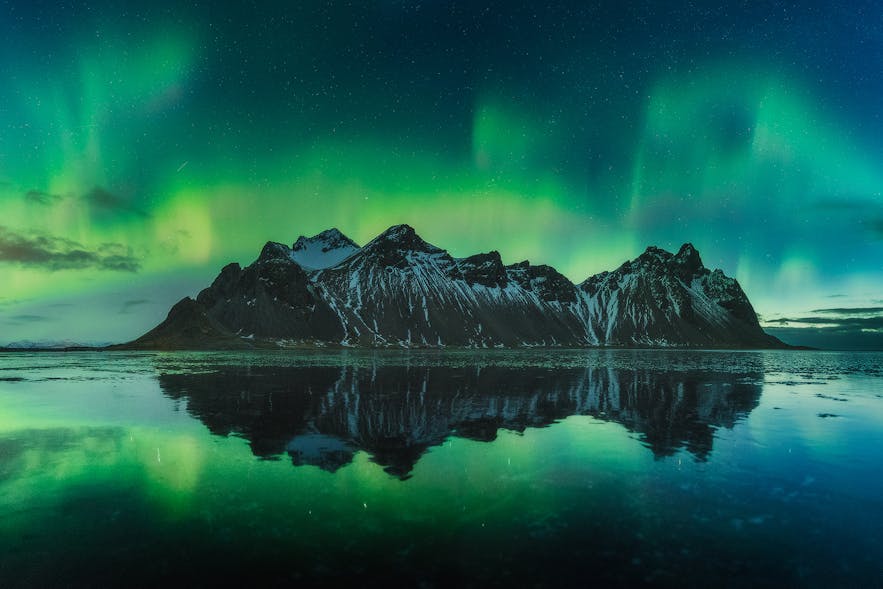 Vestrahorn is a great place to see the Northern Lights. Photo by: 'Iceland Photo Tours'.
Vestrahorn is a great place to see the Northern Lights. Photo by: 'Iceland Photo Tours'.
This rugged scree mountain tends to attract low clouds, which cling steadfastly to the jagged peaks. The result may be that not much of the mountain will be visible or that the clouds will cover up the sky.
If you are lucky, you may be blessed with clear, starry skies and the Aurora reflected in pools of water between the undulating black sand dunes at the base of Vestrahorn.
Godafoss
The Waterfall of the Gods may be beautiful in the daytime, though it’s just as resplendent during the night. It’s one of the best locations for Northern Lights photography in the north of Iceland and as such, is very popular amongst visitors.
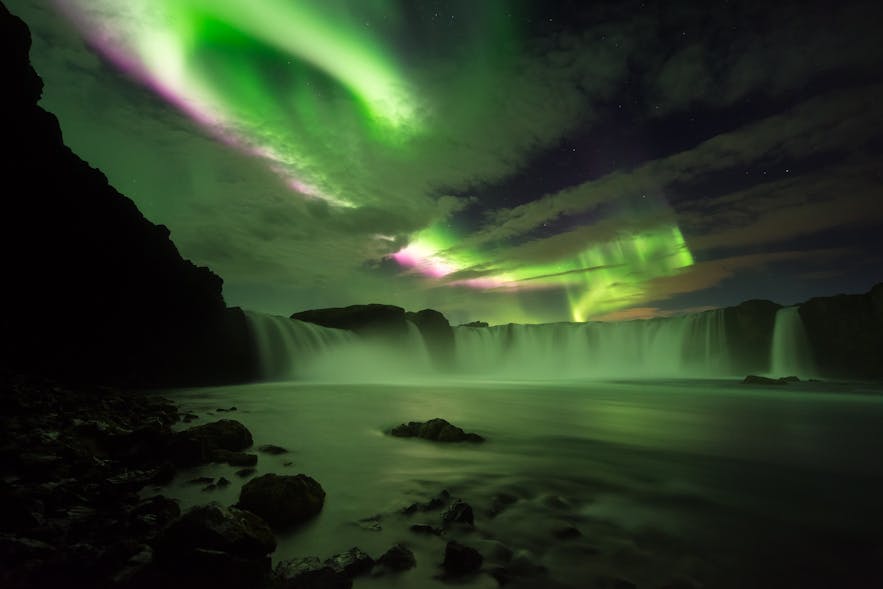 Godafoss in the north of Iceland is a wonderful place for Northern Lights photography. Photo by: 'Iceland Photo Tours'.
Godafoss in the north of Iceland is a wonderful place for Northern Lights photography. Photo by: 'Iceland Photo Tours'.
It’s not unusual to see quite a few people at the purposefully-built viewing deck during the night, either watching the Aurora or doing their best to capture it on camera.
Lake Myvatn
The volcanic lake of Mývatn is another great place to see the Northern Lights in the north of Iceland. The lake is surrounded by lava formations, as well as a number of pseudo craters, which make for astonishing foreground subjects with which to capture the Aurora overhead.
There is nothing quite like witnessing the Northern Lights reflected perfectly in the still waters of Mývatn on a cold winter’s night!
Hvitserkur
The breathtaking basalt rock formation known as Hvítserkur in the north west of Iceland may be remote but it’s a fantastic place to see and photograph the Northern Lights. Resembling a giant dragon drinking from the sea, it makes for a picturesque scene as well as a beautiful foreground.
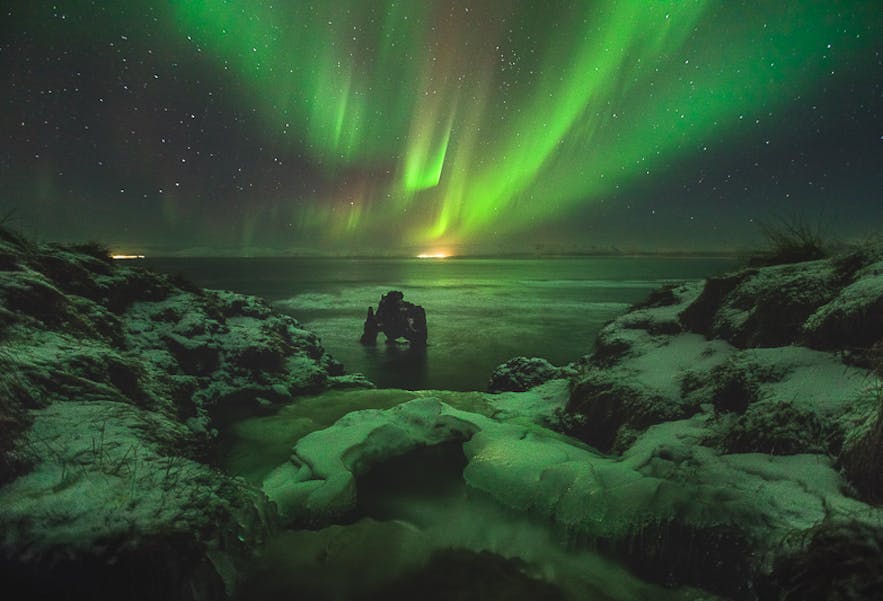 Hvitserkur can be very picturesque when the Northern Lights dance across the sky. Photo by: 'Iceland Photo Tours'.
Hvitserkur can be very picturesque when the Northern Lights dance across the sky. Photo by: 'Iceland Photo Tours'.
When the tide is low, you’ll be able to get down to the base of the stack for incredible shots. However, you can also stay up at the viewpoint by the carpark, where you’ll have amazing views of the rock stack below you and the night sky all around.
Kirkjufell
Located on the Snæfellsnes Peninsula, this is perhaps the most easily-recognised mountain in all of Iceland. Featured in the HBO series, ‘Game of Thrones’, Kirkjufell is an absolutely iconic place to see the Northern Lights. It can get busy here, even at night, though there is ample parking for all. The Aurora will usually appear from behind Kirkjufell or dance over its peak, so be sure to position yourself in front of it near the Kirkjufellsfoss waterfall for the best view!
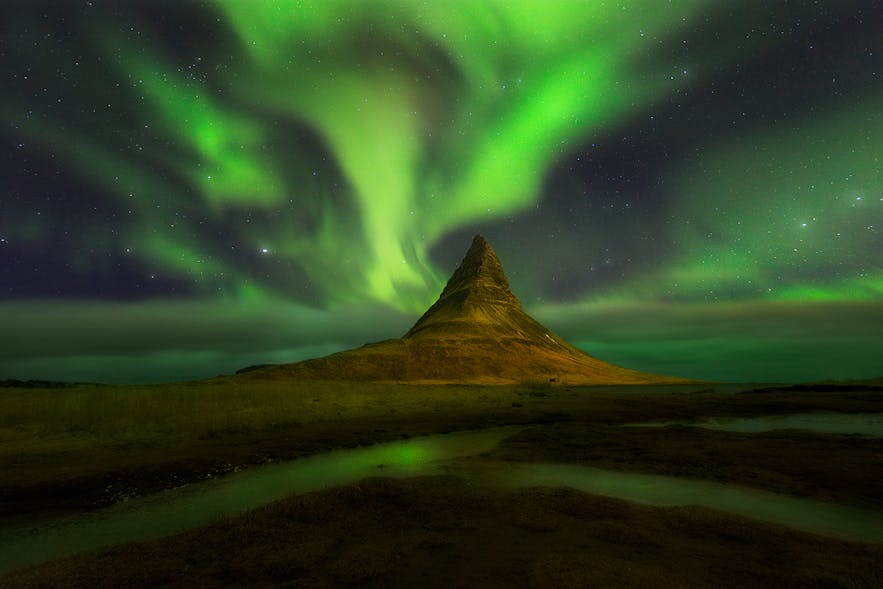 Kirkjufell is a popular spot to watch the Northern Lights. Photo by: 'Iceland Photo Tours'.
Kirkjufell is a popular spot to watch the Northern Lights. Photo by: 'Iceland Photo Tours'.
Black Church of Budir
Another amazing location to see the Aurora on the Snæfellsnes Peninsula is at the black church of Búðir. Situated in a vast lava field, this small but charming church is a wonderful spot to photograph the Northern Lights, or simply to watch them dancing overhead.
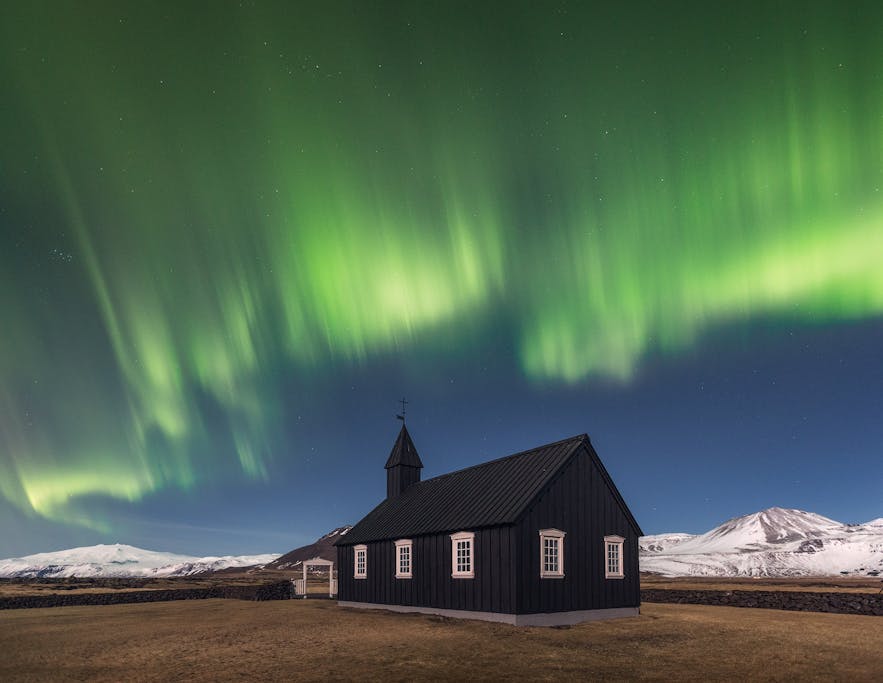 The black church of Budir offers a beautiful landscape to photograph the Northern Lights. Photo by: 'Iurie Belegurschi'.
The black church of Budir offers a beautiful landscape to photograph the Northern Lights. Photo by: 'Iurie Belegurschi'.
If the cloud situation is not favourable on this side of the peninsula, then you can always head further west towards the fishing village of Arnarstapi or north towards Kirkjufell for better viewing opportunities.
About the author: Serena Dzenis is a landscape photographer based in Iceland. You can find more of her work on her website or by following her on Facebook and Instagram.
Would you like to see the Northern Lights in Iceland? Check out our winter photography workshops or join us on a Complete Two Week Winter Photography Workshop in Iceland.
Other interesting articles

Understanding White Balance in Photography
White balance is one of the most important yet less-considered settings of a camera when it comes to producing compelling images. A slight change towards a warmer or a cooler colour temperature can...Read moreHow to Use Complementary Colours in Photography
The specific reasons why we find certain photographs more appealing than others can remain somewhat of a mystery to us. While it’s true that we can look at a picture and say “This place looks beauti...Read more
Ultimate Guide to Focus Stacking
You’ve heard of it. You’ve done some research about it. You have felt overwhelmed by it. There are legends which cause some people to shiver just by hearing someone talk about it. Yes, you probably...Read more









